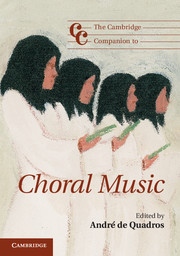Book contents
- Frontmatter
- 1 Introduction: choral music – a dynamic global genre
- Part I Choral music: history and context
- Part II Choral music the world over
- 6 Choral music and tradition in Europe and Israel
- 7 Canada's choral landscape
- 8 A multiplicity of voices: choral music in the United States
- 9 A hundred years of choral music in Latin America 1908–2008
- 10 Choral music in East Asia: China, Japan, and Korea
- 11 New voices in ancient lands: choral music in South and Southeast Asia
- 12 From chanting the Quran to singing oratorio: choral music in West and Central Asia
- 13 Voices of the Pacific: the (ch)oral traditions of Oceania
- 14 Choral music in Africa: history, content, and performance practice
- Part III Choral philosophy, practice, and pedagogy
- Notes
- Select bibliography
- Index
- Cambridge Companions to Music
11 - New voices in ancient lands: choral music in South and Southeast Asia
from Part II - Choral music the world over
Published online by Cambridge University Press: 28 September 2012
- Frontmatter
- 1 Introduction: choral music – a dynamic global genre
- Part I Choral music: history and context
- Part II Choral music the world over
- 6 Choral music and tradition in Europe and Israel
- 7 Canada's choral landscape
- 8 A multiplicity of voices: choral music in the United States
- 9 A hundred years of choral music in Latin America 1908–2008
- 10 Choral music in East Asia: China, Japan, and Korea
- 11 New voices in ancient lands: choral music in South and Southeast Asia
- 12 From chanting the Quran to singing oratorio: choral music in West and Central Asia
- 13 Voices of the Pacific: the (ch)oral traditions of Oceania
- 14 Choral music in Africa: history, content, and performance practice
- Part III Choral philosophy, practice, and pedagogy
- Notes
- Select bibliography
- Index
- Cambridge Companions to Music
Summary
Context and origins
The continent of Asia has always been something of a mystery to those in the West. Even by knowledgeable people, it is perceived as exotic and far too complex to be understood completely. With choral music it is no different. Questions that are often asked concern the types of choir that exist, what repertoire these choirs sing, in which contexts they function, what the composers write, and so on. These questions are partly being answered by the increasing global presence of South and Southeast Asian choirs, many of them participating in international festivals and competitions. The ones that travel are, however, representative of only a small number of choirs with the aspirations and resources to undertake such ambitious endeavors. The subcontinent of South Asia (where over one-fifth of the world's population lives) along with the Southeast Asian region encompasses twenty-one countries and a population of well over 2.5 billion. Group singing traditions were rich and varied well before the onset of Western contact. Even part-singing, not in the way that we understand Western choral music, but in various forms of antiphonal, call and response, and parallel intervallic singing, predates the colonial period. One only needs to examine Yampolsky's treasure trove collection of Indonesian field recordings, some of which he describes as “choral”, the bodu beru group singing with drum ensembles in the Maldives, or the Buddhist temple chants in Laos and elsewhere in Southeast Asia, to begin to appreciate this rich landscape.
- Type
- Chapter
- Information
- The Cambridge Companion to Choral Music , pp. 159 - 168Publisher: Cambridge University PressPrint publication year: 2012
- 1
- Cited by



